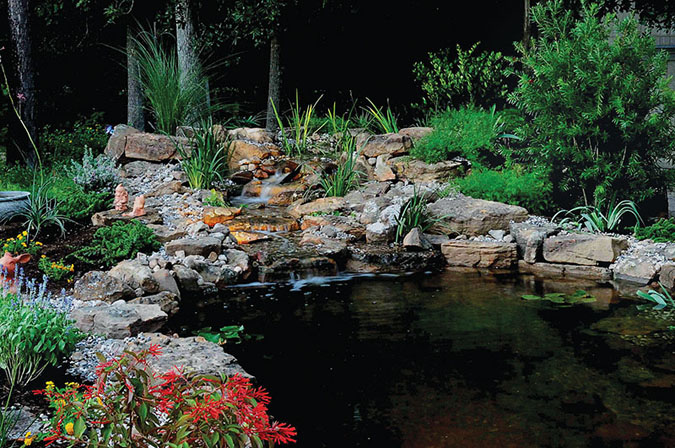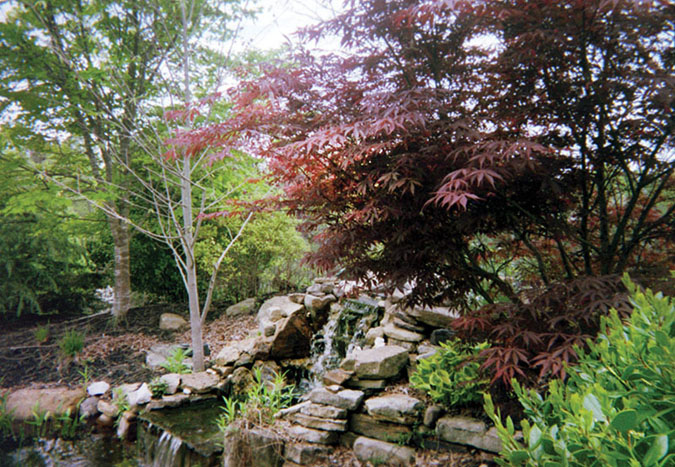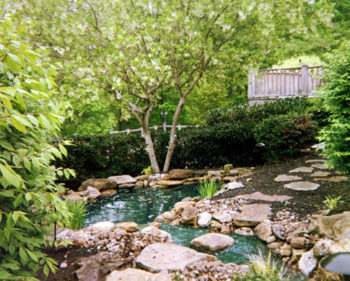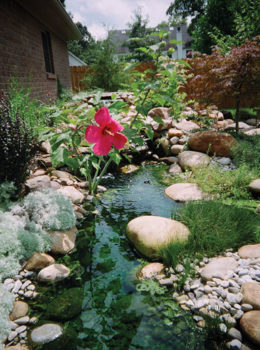
It seems that every nature and landscape photographer seeks out the lake with the reflection of trees or mountains in the water. These are the shots that make for calendar photos that hang on the walls of old-timers like me. Let us consider building our water gardens where they will receive both the shade and the reflecting beauty of a nearby tree. We will explore what works and what may cause a headache.
When a pond builder appraises the location of a new customer who desires a pond or stream with waterfalls, there are quite a few items on my mental checklist. Where will the homeowners and guests view the new pond or waterfall? How big of a pond is desired? How big is affordable? And, is there any shade? Sure, there are other factors to be considered, but I always look to add a tree to the design if there isn’t one nearby the location of the future water garden.
Pros & Cons
On the plus side is shade — it’s so much easier to keep fish and wildlife content with the presence of shade, and there is much less aggravation with algae growth. A shallow pond in the South that is situated in the middle of a treeless yard is not a good situation for anyone, including fish and frogs who may have 90-degree water in the afternoons and 60-degree water before sunup. The full sun and hot water also encourage weeds and algae.
After all, in nature, streams and ponds are almost always lined in some manner with trees, grasses or shrubbery. If the customer wants a natural-looking pond, locating the pond in the middle of a grassy yard or beside a concrete patio only works if you’re willing to plant some trees and shrubs to go with it.
The cons? First, of course, is the leaves that will ultimately fall. But I hardly ever see a pond, no matter how far removed from trees it may be, that won’t have some leaves in the bottom in the winter or spring. Akin to that is the litter of blossoms, seeds and other messiness that may fall from trees close to a pond or waterfall. Then, finally, there is the worry of tree roots tearing a hole in the liner or disrupting the integrity of the pond.
I have many years of experience, so I’ve seen most situations. If I know one thing, I know I will pick shade over a few leaves in the skimmer net every single time.
So, why do so many pond “authorities” and books tell new pond owners that they need to stay away from trees and put their ponds out in the open? My guess is that these people don’t own a pond and don’t really love ponds; they just like the idea of a published book with their name on the cover. After all, it sounds sensible to avoid the trees and problems that might go with them. Or, maybe they see too many ponds built without modern biofalls or skimmers that are always trashy.
The Pond Shrub Club
Here are some suggested trees that I would use to shade a waterfall or pond. By no means is this a complete list, partly because I live in a temperate Zone 6 — near Appalachia. I use Japanese maples such as Bloodgood or many other clones, with the idea that they should get big enough to provide some shade. I like serviceberries (amelanchier), for shade and for the fruit — the birds and I both love it! I also love yellowwood (Cladrastus kentukea); sometimes I use hemlock, pawpaws, ginkgo, fringe trees, crepe myrtle and junipers to give my ponds some shade and some character. Even a scarlet oak or blackgum tree would work.

These trees either have roots that are fine and shallow or taproots that go deep and don’t bother the pond. Note that any tree can send roots over a liner’s edge and into the water, where it acts like a straw in a soft drink, sucking up pond water and creating that leak in the springtime you often cannot find. Cherries and willows seem to smell water and climb over obstacles with their roots to get to it.
Avoidable Headaches
Let’s begin with any trees that are super messy. This includes river birch, sycamore and black walnut. The black walnut contains juglone, which is harmful to other plants, and even fish. I would also avoid brittle trees, such as Bradford pears. Redbuds, too, have big, shallow roots, messy seeds and falling blooms.
Pine trees look good near the water, but I find that the needles can clog pads, get past magdrive pump screens, ruin or render ineffective backflow valves, be prone to fall in wind or ice storms and have shallow roots that may end up in the pond.


[box style=”rounded”]The pond, left, was constructed in the shadow of a white fringe tree. At the right, the same feature — 10 years later — is in excellent shade.[/box]
Anecdotally, there can be problems with trees and ponds. But from my nearly 20 years of experience, I’ve seen no tree, flower, weed or anything else send roots through a pond liner from below if the pond also had a nonwoven, geopad-type underlayment under the rubber. Without such protection, I have seen Russian sage and euonymous roots penetrate a liner that lacks something for padding. I also highly suspect bamboo, thalia and cattails are capable of putting holes in a good-quality liner if care isn’t taken from the beginning.
Can large trees be a problem? Perhaps. You don’t want to cut roots bigger than an inch or two in diameter in order to dig your pond, because removing large roots could cause nearby trees to die entirely. But, the worst I’ve had to deal with was a homeowner wanting a pond between a lovely dogwood and redbud next to her patio. In excavating, I found a major root about 10 inches down at one point. I made a shallow end to the pond and let the water have almost a little stream effect as it headed to the skimmer. Over the years, more than a decade now, the dogwood has died, and the redbud is old and frail, with the root pushing the liner, making the water about 4 inches deep at that point. However, this is the biggest redbud I’ve ever seen, so it’s not likely to grow a lot more. If the redbud should die, this homeowner will have a pond in the sun unless she lets me plant another tree for her.
In summary, I’ll take the leaves and trash of a tree or two near my pond in exchange for the shade. The troubles with a hot, sunny pond exceed the messy troubles of a tree in my opinion. The cool shade and more attractive appearance are simply bonuses when landscaping a water feature with some trees.



As the owner of Rock Castles, thanks for sharing the topic with a wider audience. Since you shared it with my name and company…I have no problem with that. And I know my pond friend, Max Taylor of Magnolia Ponds in Houston TX who made a photo contribution to the story also has no problem. Happy pondering! Max
We’ll hope all the ponds in the path of the hurricanes are surviving along with their owners. Max
Thanks for the info. I was trying to decide whether to put a new pond in the shade or not and you help me make up my mind. I agree I would rather have the mess of a few leaves than have a hot water pond. Beside, it looks better when landscaped.
Good choice I believe. A good skimmer, and good water flow from waterfall to skimmer will help with corralling the leaves. Max
Greetings! What is your recommendation for protecting the pond liner from bamboo? I’m putting in a small pond and already have bamboo growing on one side, I would like to keep it if possible. I appreciate your advice!